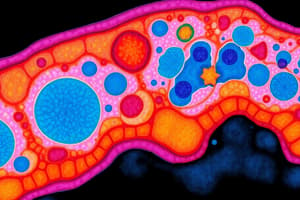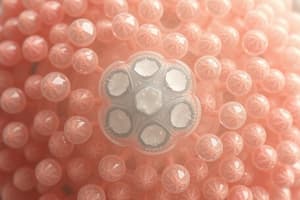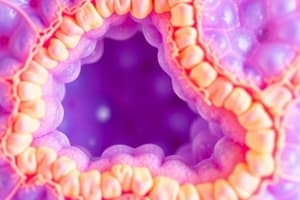Podcast
Questions and Answers
What is simple epithelial?
What is simple epithelial?
Single layer of cells.
What is stratified epithelia?
What is stratified epithelia?
Two or more layers of cells.
What are the names of shapes of cells?
What are the names of shapes of cells?
- Cuboidal (correct)
- Triangular
- Squamos (correct)
- Columnar (correct)
What are squamos cells?
What are squamos cells?
What are cuboidal cells?
What are cuboidal cells?
What are columnar cells?
What are columnar cells?
Where are simple epithelia found?
Where are simple epithelia found?
What is simple squamous epithelium?
What is simple squamous epithelium?
What is endothelium?
What is endothelium?
What is mesothelium?
What is mesothelium?
What are the functions of simple cuboidal epithelia?
What are the functions of simple cuboidal epithelia?
What is nonciliated simple columnar epithelium?
What is nonciliated simple columnar epithelium?
Where is ciliated simple columnar epithelium found?
Where is ciliated simple columnar epithelium found?
What is pseudostratified columnar epithelium?
What is pseudostratified columnar epithelium?
What is nonciliated pseudostratified columnar epithelium?
What is nonciliated pseudostratified columnar epithelium?
Where is ciliated pseudostratified columnar epithelium found?
Where is ciliated pseudostratified columnar epithelium found?
What are stratified epithelial tissues?
What are stratified epithelial tissues?
Where is stratified squamous epithelium found?
Where is stratified squamous epithelium found?
What is stratified cuboidal epithelium?
What is stratified cuboidal epithelium?
What is stratified columnar epithelium?
What is stratified columnar epithelium?
What is transitional epithelium?
What is transitional epithelium?
Flashcards are hidden until you start studying
Study Notes
Classification of Epithelial Tissue
- Epithelial tissues are classified based on the number of layers (simple or stratified) and cell shape (squamous, cuboidal, columnar).
Simple Epithelium
- Consists of a single layer of cells, facilitating absorption, secretion, and filtration.
- Found in organs like kidneys, alveoli, and capillaries where diffusion is prioritized.
Simple Squamous Epithelium
- Cells are flattened and thin, allowing rapid diffusion.
- Cytoplasm is sparse, enhancing permeability.
- Locations include kidneys, lungs, lining of the heart, and blood vessels (endothelium).
Endothelium and Mesothelium
- Endothelium: Lines blood vessels and heart, part of simple squamous epithelium.
- Mesothelium: Covers serous membranes in the ventral cavity, also part of simple squamous epithelium.
Simple Cuboidal Epithelium
- Comprises a single layer of box-like cells with round nuclei.
- Functions primarily in secretion and absorption.
- Forms walls of small ducts and kidney tubules, and covers ovary surfaces.
Simple Columnar Epithelium
- Made of tall, closely packed cells, promoting absorption and secretion.
- Ciliated type aids in moving mucus; non-ciliated type lines the digestive tract.
Pseudostratified Columnar Epithelium
- Appears stratified due to cell height variation but is a single layer.
- Functions in secretion and absorption; can be ciliated (found in the trachea) or non-ciliated (in male reproductive ducts).
Stratified Epithelia
- Composed of two or more cell layers, providing durability and protection against wear.
- Basal cells continuously regenerate to maintain the layer.
Stratified Squamous Epithelium
- Most common stratified type, resistant to abrasion.
- Found in places subjected to friction, such as the esophagus, mouth, vagina, and skin.
Stratified Cuboidal Epithelium
- Rare type, typically two cell layers thick.
- Found in sweat and mammary glands.
Stratified Columnar Epithelium
- Limited distribution; exists in specific regions like the pharynx and male urethra.
- Transitional areas between different epithelium types often contain this layer.
Transitional Epithelium
- Unique structure allows for stretching as organs like the bladder fill.
- Basal cells are typically cuboidal or columnar; apical cells change shape based on the organ’s state.
- Locations include the ureters, bladder, and parts of the urethra.
Studying That Suits You
Use AI to generate personalized quizzes and flashcards to suit your learning preferences.




